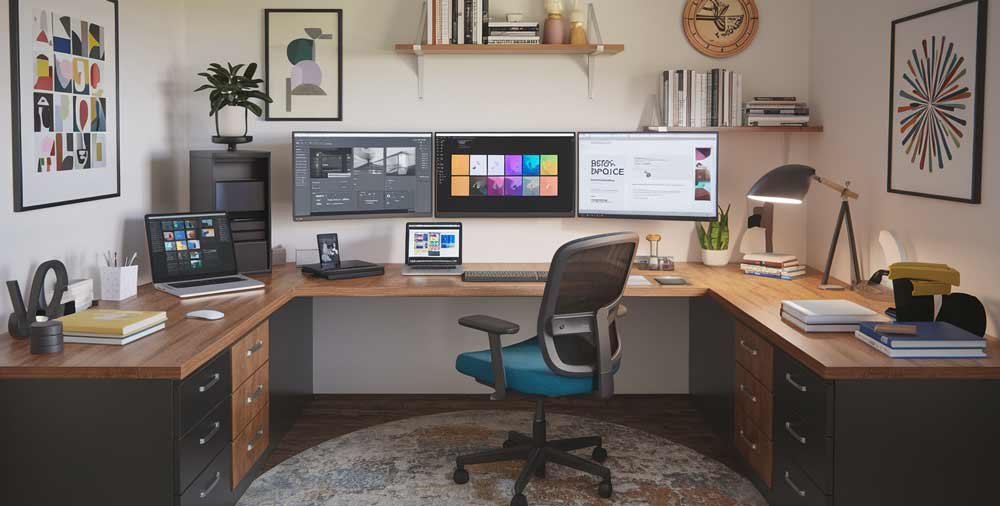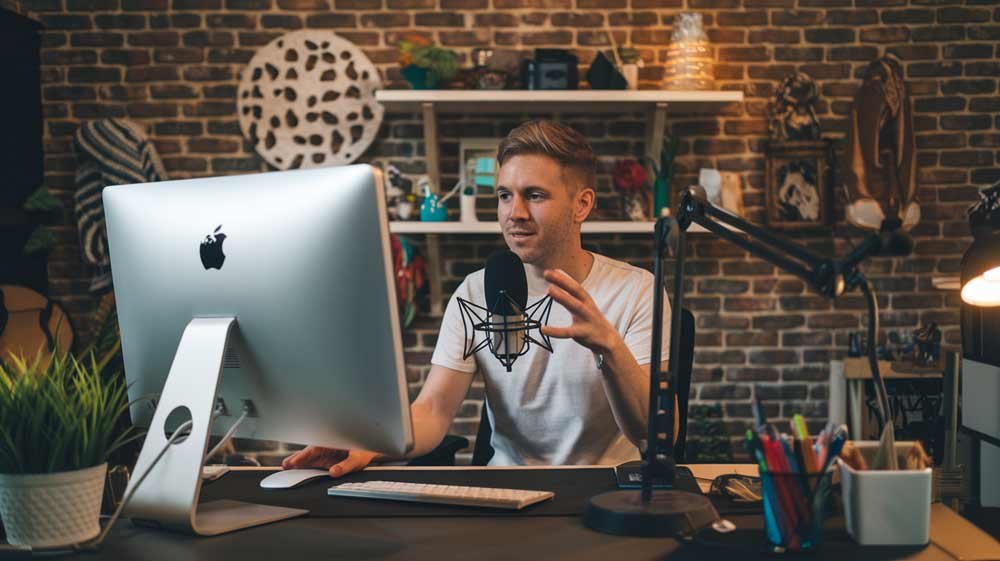Why Creating a Productive Workspace Matters in 2024

Remote work has become a standard practice for millions of people around the world. With the rise of flexible working hours, the need for an optimal home office setup has never been more crucial. In 2024, remote workers face new challenges and opportunities as they design workspaces that enhance both productivity and well-being.
Creating a productive workspace is more than just setting up a desk and chair. It’s about crafting an environment that maximizes efficiency, reduces distractions, and supports your physical and mental health. Whether you’re a seasoned remote worker or someone new to working from home, having the right workspace design can make a huge difference in your daily output and long-term success.
In this article, we’ll explore practical design tips for remote workers in 2024, diving into areas such as lighting, ergonomics, personalization, and the latest trends in home office design. You’ll also find advice on how to avoid common pitfalls and build a workspace that suits your needs.
What Defines a Productive Workspace?
Understanding the Basics of a Productive Workspace
A productive workspace is more than just a functional setup—it’s a place where creativity, focus, and efficiency thrive. The design and layout of your workspace directly impact how you work, influencing everything from your mood to your ability to concentrate on complex tasks.
So, what defines a truly productive workspace? At its core, it needs to be a blend of comfort and functionality. A space where you can focus on tasks without distractions while maintaining comfort throughout the workday. Key components often include an ergonomic chair, a well-positioned desk, and sufficient lighting. However, a productive workspace goes beyond the basics to include elements that motivate and inspire.
Psychological Impact of Workspace Design
The design of your workspace doesn’t just affect your physical comfort—it plays a crucial role in your mental state too. Studies have shown that well-designed work environments can boost motivation, improve mood, and even reduce stress. For example, a study published in the Journal of Environmental Psychology highlighted that environments with natural elements like plants and daylight exposure significantly improve cognitive function and emotional well-being.
A well-structured workspace reduces decision fatigue, allowing you to work more efficiently. Each element, from your desk setup to your room layout, should encourage ease of access and flow. Clutter-free spaces, soothing colors, and comfortable furniture can help foster a sense of calm and concentration.
Ergonomics and Comfort
One of the most important aspects of a productive workspace is ergonomics—the science of designing spaces that align with the physical needs of your body. Poor posture and uncomfortable seating can lead to chronic pain, fatigue, and distractions that kill productivity. In fact, the U.S. Occupational Safety and Health Administration (OSHA) suggests that poor ergonomics costs businesses billions in lost productivity each year.
To avoid these issues, consider investing in ergonomic furniture. Here are some essential ergonomic tips for your home office setup:
- Ergonomic chair: Choose a chair that supports the natural curve of your spine. Adjustable chairs with lumbar support are ideal for maintaining proper posture.
- Desk height: Your desk should be at a height where your forearms rest comfortably on the surface while typing, with elbows at a 90-degree angle.
- Monitor placement: Your computer screen should be at eye level, about 20-30 inches away, to avoid neck strain.
Investing in ergonomically sound furniture doesn’t just improve comfort—it significantly boosts long-term productivity by reducing strain and fatigue. As a remote worker in 2024, these factors are more important than ever as more people spend extended hours working from home.
Design Tips for a Productive Home Office in 2024
When it comes to creating a productive home office, the design choices you make play a key role in your ability to work efficiently and stay focused. In 2024, remote workers are increasingly embracing modern, adaptable design elements that blend functionality with comfort. Let’s explore several core design tips that will help you craft the perfect workspace for optimal productivity.
Lighting: A Critical Component of Productivity

Lighting is often an overlooked aspect of home office design, but it’s one of the most important factors influencing your productivity. Poor lighting can cause eye strain, headaches, and fatigue, while the right lighting setup can improve focus, mood, and overall work performance.
- Natural Light Boosts Productivity
Natural light is the best type of lighting for your workspace. A study by the Journal of Clinical Sleep Medicine found that workers exposed to natural light sleep better, experience less stress, and are more productive compared to those in poorly lit environments. If possible, position your desk near a window to maximize exposure to natural daylight. Not only does this provide a constant source of good lighting, but it can also boost your mood and keep you energized throughout the day. - Artificial Lighting Solutions
For remote workers who may not have access to adequate natural light, artificial lighting becomes crucial. Choose light bulbs that emit soft, warm light to reduce glare and eye strain. Consider investing in an adjustable LED desk lamp that allows you to change brightness levels depending on the time of day.
Some smart lighting systems even allow you to sync your lighting to your daily schedule, automatically dimming or brightening based on your workflow needs.
Here are a few tips for choosing artificial lighting:
- Use multiple light sources: Layer your lighting with ambient (overhead), task (focused desk lamp), and accent lighting.
- Avoid harsh lighting: Fluorescent lighting can lead to eye strain and discomfort, so opt for soft, adjustable lighting wherever possible.
Noise Reduction Strategies for a Productive Workspace
Noise is one of the most common distractions for remote workers, especially those working from home with family members or in urban environments. To create a productive workspace, it’s essential to implement strategies that reduce or eliminate noise.
- Soundproofing Solutions
Soundproofing your workspace can significantly reduce outside noise, allowing you to focus better on your tasks. You don’t have to completely renovate your home to achieve this; simple changes like using thick curtains, adding a carpet or area rug, and hanging acoustic panels can absorb sound and reduce echo in your room. - Noise-Cancelling Headphones
For those who don’t want to make structural changes, investing in a quality pair of noise-cancelling headphones can be a game-changer. Many remote workers rely on these to block out distracting sounds, whether it’s background chatter, construction noise, or even the hum of household appliances. These headphones are designed to filter out ambient noise, helping you stay focused even in noisy environments. - White Noise Machines
If you find silence distracting, you might benefit from a white noise machine. These devices generate neutral background sounds like rain or ocean waves, which can help drown out more disruptive noises. In fact, studies have shown that white noise improves focus, especially in environments where unpredictable sounds frequently occur.
Decluttering and Minimalist Design for Enhanced Focus

A cluttered desk can lead to a cluttered mind. Minimalist design principles have proven to be effective in creating a calm and organized workspace that fosters concentration and efficiency.
- The Importance of a Decluttered Workspace
When your workspace is filled with unnecessary items, it can overwhelm your brain and make it difficult to focus. According to a study published in the Journal of Neuroscience, visual clutter competes for your attention, making it harder to concentrate and process information. - Tips for Organizing Your Desk and Workspace
Start by removing anything from your desk that doesn’t directly contribute to your work. Use desk organizers to keep essential items within easy reach without creating visual clutter. Utilize storage bins and shelving to store paperwork, files, and other items that you don’t need on a daily basis.
Minimalist design isn’t just about reducing clutter—it’s about intentionality. Choose functional furniture and décor that serve a clear purpose and contribute to a clean, streamlined aesthetic. Here are some minimalist design tips to consider:
- Limit personal items: While a personal touch can be motivating, keep it to a minimum. A single framed photo or plant can add personality without creating clutter.
- Cable management: Use cable organizers to keep your cords and wires out of sight for a neater, more organized desk.
By incorporating these minimalist workspace design principles, you’ll create an environment that fosters focus, creativity, and mental clarity.